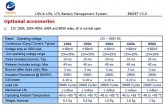electric
Solar Enthusiast
Looks interesting, but no information on coil ratings. The picture indicates a dual coil which reduces consumption after contact is pulled in, which is a very good feature for BMS applications, but still not clear what holding current would be, which also depends on coil voltage.Hmmm... The Chargery BMS I am using shipped with continuous duty Normally Open contactor relays. The BMS put's out 12v/3a max for the relay switching. They are big (even for 200A) and loud when they snap closed. I did a quick search on the model and they come up on ebay etc in the $40-$60 range.
Identical to this below for a 200A (they come In 12/24/36/48 volt models.)
The PN I have for 12V 200A is MZJ-200A-D

New New Heavy Duty Golf Cart 24V MZJ-200A 200A Contactor Solenoid | eBay
Find many great new & used options and get the best deals for New New Heavy Duty Golf Cart 24V MZJ-200A 200A Contactor Solenoid at the best online prices at eBay! Free shipping for many products!www.ebay.com
Cheaper here on Aliexpress (not sure if same company)

16.15US $ 5% OFF|1Pcs MZJ 200A DC Contactors DC12V DC24V DC36V DC48V|Relays| - AliExpress
Smarter Shopping, Better Living! Aliexpress.comwww.aliexpress.com
This is obvious for experienced people, but I see some real newbies here, so to be clear you need to pick the relay with coil voltage matching your battery voltage.
@Steve_S are you able to measure holding current of your relays? Does your relay also show a picture of a dual coil L1/L2 where one coil is bypassed initially until contact is pulled in?



